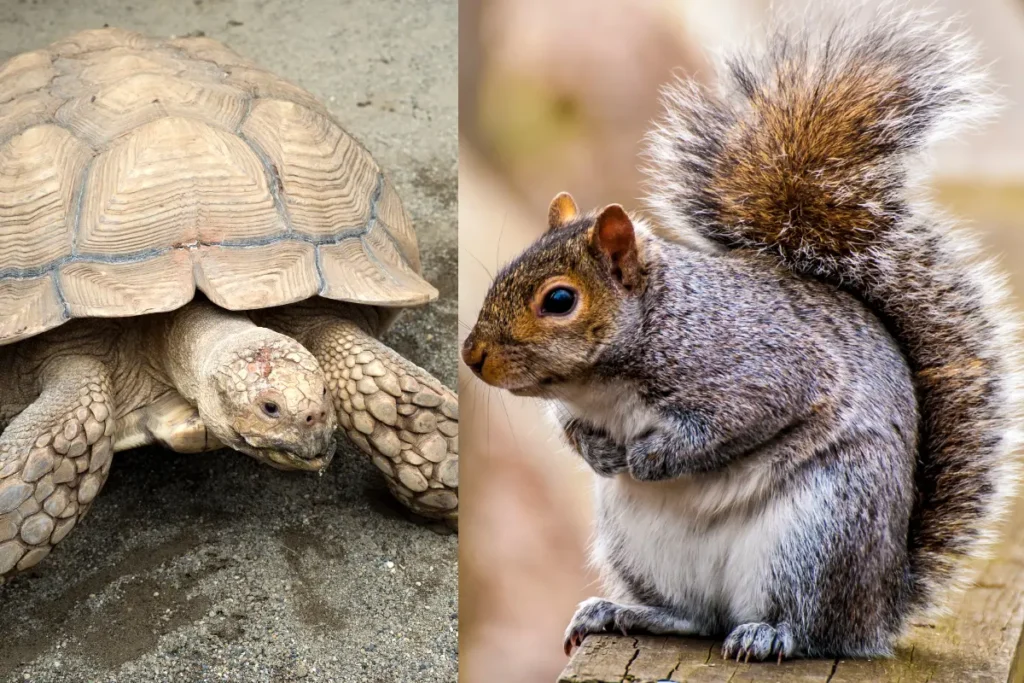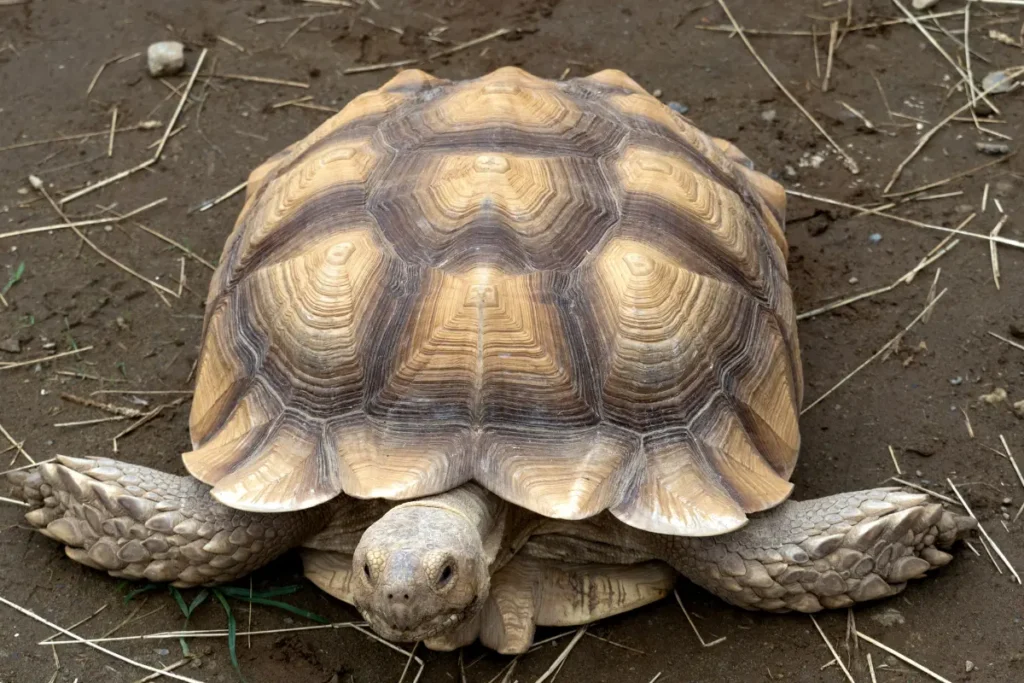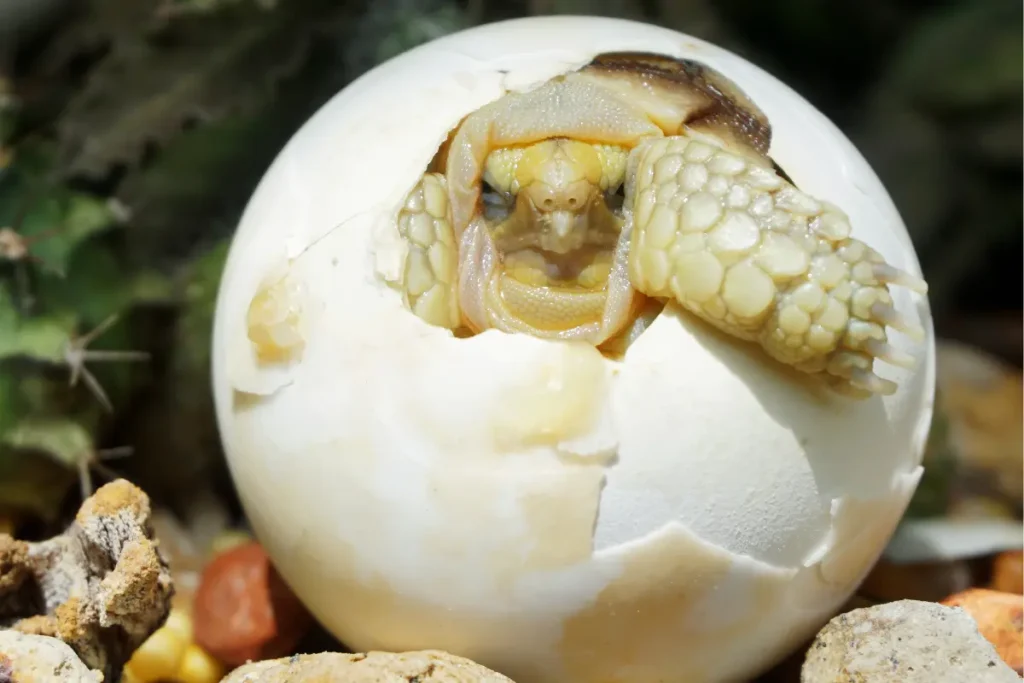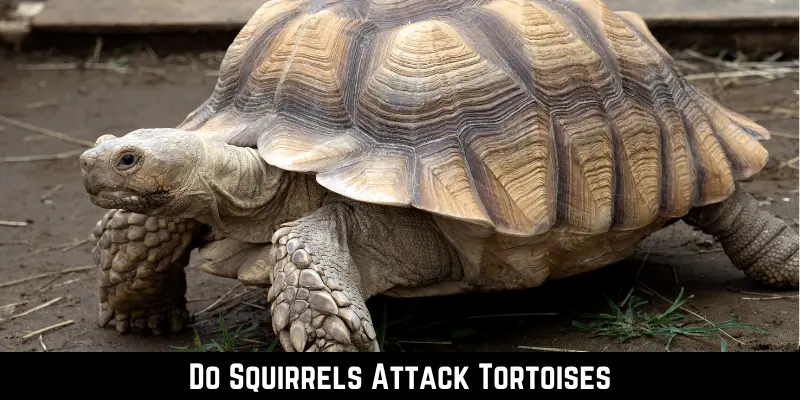The Turtles known as tortoises are those that cannot survive in the. Some animals can still feed on even when they have fully grown adults with hardened shells. Adult tortoises are preyed upon by many animals’ including coyotes and kit foxes. Rodents such as rats are also known to gnaw on tortoises, causing serious injury but what about squirrels, do Squirrels Attack Tortoises?
Yes, squirrels attack young tortoises and their eggs but do not attack adult tortoises. Because adult tortoises use their shells to protect themselves from predators.
Predators of juvenile tortoises and tortoise eggs include ground squirrels, ravens, and roadrunners. Read the entire article to learn more about tortoise predators.
Squirrels And Tortoises

Squirrel is a common term for a fluffy-tailed, tree-climbing rodent, also known as a “tree squirrel.” Although cute, furry rodents are much smaller than we are, they may share more traits with us than we previously realized.
Squirrels are omnivores, which means they eat insects, eggs, and even small birds, smaller mammals, and frogs in addition to a wide variety of plant food such as nuts, seeds, fruits, fungi, and green vegetation.
Tortoises are land-dwelling turtles that range in size from small to large. The majority of them have an elevated top shell or carapace. Their back legs are thick and resemble elephant legs in appearance. Contrarily, the front legs are relatively flat and covered in big scales.
Tortoises have a variety of defense mechanisms at their disposal, including hiding inside their shells. Numerous tortoises possess musk glands, which are tiny sacs that secrete an odoriferous substance as a form of defense.
Why Are Squirrels Attacking?
Squirrels can attack in order to protect their young. The likelihood of a sick squirrel acting hostile or aggressive toward humans and other animals is higher. It’s not always possible to determine the reason why a squirrel attacked, though.
Do Squirrels Eat Tortoises?

Squirrels are nut-loving, adorable rodents; however, they are also omnivores. They consume both plant and animal matter, according to this. Squirrels will eat plants for the most part.
Tortoise hatchlings are just one of the many small animals they can eat, but they eat eggs, insects, and small animals when they can, they eat eggs, insects, and small animals.
As scavengers, Tortoises are classified as belonging to the 3rd trophic level in the food chain. As a result, many animals prey on them. Tortoises, of course, have a shell to protect themselves from predators.
However, their eggs and babies without shells are food for many animals.
There are numerous natural predators of tortoises of various species. Their eggs are eaten by nearly every animal that can dig them up or burrow into them. Any animal that can break an adult’s shell or extract pieces of it will eat the adult.
Will Squirrels Eat Tortoises Eggs?

Since squirrels require calcium as well as calcium-rich foods like protein and fat, it has been demonstrated that squirrels consume tortoise eggs.
Many of those calorie requirements can be satisfied by eggs, which squirrels can easily locate. After the mother tortoise departs from the nest, it can enter covertly, seize an egg, and then flee before being attacked.
After months of surviving off of stored fat and quickly running out of food supplies, squirrels may also require more food in the spring. Due to their high protein and fat content, eating eggs is one of the quickest ways to put on weight again.
Squirrels can and will eat raw eggs if they cannot find other food sources. If you put a raw egg in their feeder, they are unlikely to eat it. They’ll be tempted instead to steal a tortoise egg.
Do Squirrels Eat Baby Tortoises?

Yes, squirrels have indeed been observed eating baby tortoises and tortoise eggs. Because they contain protein and other nutrients, baby tortoise and tortoise eggs are probably eaten by squirrels.
Tortoise eggs can be discovered by squirrels in Tortoise nests. When a squirrel consumes a Tortoise egg, it digests the egg and absorbs the nutrients.
Because baby tortoises’ shells are initially soft, squirrels prey on them. It takes about 5 years to harden. Hatchlings are extremely vulnerable during these early years because they lack the cannon shell as protection like more mature tortoises do.
Few young tortoises reach adulthood. A few examples of tortoise predators include roadrunners, reptiles, kit foxes, and coyotes. The common raven, on the other hand, is a predator whose presence is significantly threatening the survival of the desert tortoise.
Even domestic dogs harass tortoises, frequently breaking their limbs before the tortoise can retreat into its shell.
What Animals Eat Tortoises Other Than Squirrels?
Tortoises, despite their extremely hard, protective shells, are prey to a variety of predators. Examples of tortoise predators include roadrunners, reptiles, kit foxes, humans, jaguars, crocodilians, and coyotes.
Jaguars: Jaguars’ exceptional jaw strength allows them to pierce tortoises’ tough shells.
Crocodilians: Crocodilians can gnaw through the shells of many turtles and tortoises because they have the world’s toughest jaws.
Humans: Humans are without a doubt the most important predator of adult tortoises. For millennia, humans have consumed turtles and tortoises.
Coyotes: Coyotes can eat tortoises without breaking their shells. This tortoise predator will not only hunt one that they see; they may even dig one out of its hole in the ground to eat.
The Golden Eagles: The tortoise’s next predators are golden eagles, which are among the world’s most lethal birds of prey.
Ravens: It is debatable whether ravens are natural tortoise predators or human-subsidized predators.
What is a Tortoise Defense Mechanism?
Turtles and tortoises are special reptiles. Their shell is an incredible defense mechanism. The exterior layer of the bone shell is covered in scutes.
The scutes, like human hair and nails, are made of keratin. Tortoises and turtles will huddle inside their shells for safety when they feel threatened.
Due to their long legs, tortoises must walk on tiptoe when it starts raining and the sludge is deep to reach their favorite foods. They eat mostly flowers and green plants, with some juicy fruits now and then.
The tortoise’s carapace, or hard upper outer shell, protects the majority of its arms and shoulders from predators. Male and female tortoises have a gular horn, which is an extended form of the plastron that they use for self-defense.
The tortoise’s mouth is pointed and resembles a beak, which helps it when it is foraging for its diet of plants.
How Do Tortoises Survive From Predators?
The following are the methods tortoises use to safeguard themselves from predators:
Camouflage: The tortoise’s tan and brown markings help it blend in with its surroundings. This allows it to avoid predators by hiding in shallow burrows.
Gular Horn: Male and female tortoises both have a gular horn, which is an extended version of the plastron, or lower shell, that they use for self-defense.
Carapace and Plastron: The majority of the tortoise’s upper body is shielded from predators by its hard outer shell, or carapace, while its underside is shielded by its plastron or under a shell.
Burrowing: Tortoises can dig burrows and shield themselves from predators by using their powerful legs and hard claws to dig into the ground.
Beak: The tortoise’s mouth is pointed and resembles a beak, which helps it when it is foraging for its diet of plants. If necessary, the tortoise can defend itself by snapping its beak.
Can Tortoise Survive Without Shell?
Tortoises and turtles cannot survive without their shells. They are unable to easily put on or remove the shell. It is fused to the bones of tortoises and turtles, and they can’t live without it. Tortoises have keratin-coated shells that are very hard and bone-like.
The shells of sea turtles are covered in a leathery covering. Shells from both land and sea turtles can land anywhere in between. Because a tortoise or turtle’s shell contains nerve endings, it can feel your touch and becomes painful if it is damaged.
A tortoise’s shell serves as its protective covering, just as our skin serves as our protective covering. An exoskeleton includes the tortoise shell. That simply means that a portion of the skeletal system is damaged.
That simply means that, unlike a human skeleton, a portion of the skeletal system is located outside of the body.
Conclusion
Adult tortoises are not attacked by squirrels, but young tortoises and their eggs are. Adult tortoises use their shells to defend themselves against predators.
The majority of Tortoise species can live for 80 to 150 years, which is much longer than humans. The actual life expectancy of a tortoise depends on several variables, including species, habitat, care, and diet.
Tortoises are classified as belonging to the food chain’s third trophic level. Natural predators of tortoises of various species abound. And nearly every animal that can dig up or burrow into their eggs eats them.
An exoskeleton includes the tortoise shell. Sea turtle shells are covered in a leathery covering. Land and sea turtle shells can land anywhere in between. Their shell serves as an excellent defense mechanism. Scutes are made of keratin, just like human hair and nails. When threatened, tortoises and turtles will huddle inside their shells for protection.
References
Segura A, Jimenez J, Acevedo P. Predation of young tortoises by ravens: the effect of habitat structure on tortoise detectability and abundance. Sci Rep. 2020 Feb 5



